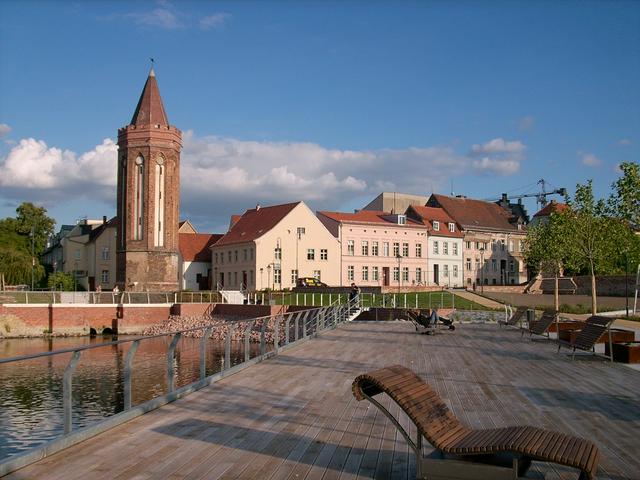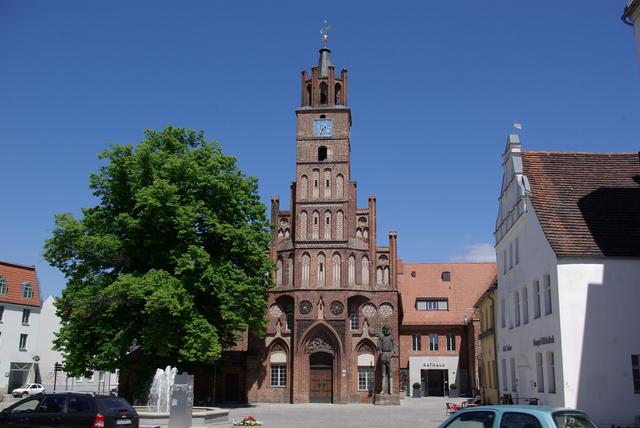Brandenburg an der Havel is the third-largest town in the German state of Brandenburg.
_(MK)-vEZOf.medium.jpg)
 Brandenburg an der Havel (sometimes called Brandenburg City to distinguish it from the eponymous state) is considered the nucleus or cradle of the historical Margraviate and today's State of Brandenburg. It was populated first by Slavs, then conquered by the troops of German King Henry I in 928 or 929. 20 years later, Otto I established the Bishopric of Brandenburg that held both religious and secular power in the region. During the 983 Great Slav Rising, it was reconquered by pagan Slavs, until Albert the Bear founded the Margraviate of Brandenburg in 1157, populating it with Christian, German-speaking settlers. The Brandenburg cathedral was started in 1165.
Brandenburg an der Havel (sometimes called Brandenburg City to distinguish it from the eponymous state) is considered the nucleus or cradle of the historical Margraviate and today's State of Brandenburg. It was populated first by Slavs, then conquered by the troops of German King Henry I in 928 or 929. 20 years later, Otto I established the Bishopric of Brandenburg that held both religious and secular power in the region. During the 983 Great Slav Rising, it was reconquered by pagan Slavs, until Albert the Bear founded the Margraviate of Brandenburg in 1157, populating it with Christian, German-speaking settlers. The Brandenburg cathedral was started in 1165.
From the 12th to 18th century, Brandenburg actually consisted of two cities, separated by the River Havel and each protected by its own walls: one centred around the castle, serving as the capital of the secular Margraviate of Brandenburg; and one containing the cathedral, being the residence of the religious Prince-Bishopric of Brandenburg. After the Reformation, the Bishopric was annexed by the Margraviate. The Hohenzollern dynasty moved the capital of the Margraviate to Berlin after 1415, nevertheless Brandenburg an der Havel long claimed to be the higher-ranking city due to its old age. During the Thirty Years War, Brandenburg was severely damaged, lost most of its population and importance.
The town experienced a second boom during industrialisation. The Brennabor works were a famous producer of bicycles, prams, cars and motorcycles; and the town's population doubled within a few decades. Under East Germany's communist rule, Brandenburg again was a site of heavy industries, having major steelworks and mills. After reunification, it was deindustrialised, many people lost their jobs and moved away. Instead, the town of some 70,000 inhabitants now focuses on culture, gardens and tourism, having hosted the federal horticultural show in 2015.
Berlin's most famous landmark, the Brandenburg Gate, is named after Brandenburg an der Havel.
_01_(MK)-RSkRu.medium.jpg)
- St Peter and Paul's Cathedral. A first cathedral was erected in the mid-10th century, but it was lost during the Great Slav Rising. The present building was started in 1165, built from bricks and designed in a late-Romanesque to early-Gothic style. It is considered the "cradle" of Brandenburg and "mother" of all churches in the state. The cathedral is situated on an island (Dominsel) in the River Havel which also contains the cathedral's enclosure, the former knight academy, curiae, cathedral canon's houses and the Gothic St Peter's Chapel.
-pLhpv.medium.jpg)
- St Catherine's Church. The city's biggest church (bigger than the cathedral), main parish church of the "New Town"; three-aisled, late-Gothic hall church with beautifully decorated ceiling. The organ has a lavishly decorated Baroque façade.
- St Gotthard's Church. Main church of the "Old Town"; served as the bishop's church before the completion of the cathedral. The westwork's base is Romanesque, while the church's main parts are Gothic.
- St John's Church. Former Franciscan monastery; late-Gothic, two-aisled hall church built from bricks. It was severely damaged during the Second World War; the ruin was repaired after 2013, and is used partly as a church, partly as an event location.

- Town hall of the Old Town. Imposing brick Gothic town hall with ornated gates, Roland statue. On the Old Town's marketsquare is the Ordonnanzhaus (an early 14th-century brick building, one of the oldest secular buildings in Brandenburg), the Renaissance Sekretariats- und Syndikatshaus and the Baroque Inspektorhaus.
- Remains of the medieval city fortifications of the Old Town and New Town:
- Steintorturm, Steinstraße (Tram 1 or 2 "Große Gartenstraße", +49 3381 584501. Apr–Oct: Tu-Su 13:00-17:00. Mightiest of the New Town's gate towers; hosts a museum of local history. Admission €3 (children free).
- Neustädtischer Mühlentorturm. Late-Gothic gate tower, built from bricks.
- Rathenower Torturm. Oldest extant gate towers of the Old Town
- Plauer Torturm.
- Millenial bridge. Bridge over the River Havel, connecting the Old with the New Town. It was completed in 1929, celebrating the millennial anniversary of the city.
- Archeological Museum at St Paul's Monastery, Neustädtische Heidestraße 28, +49 3381 4104112. Tu-Su 10:00-17:00, closed on Mondays, New Year, Good Friday, Christmas Eve, New Year's Eve. Presents 10,000 archeological findings from 50,000 years of history. It's in a 13th-century Gothic former Dominican monastery. Admission €5 (reduced €3.50).
- Industrial museum, August-Sonntag-Straße 5 (Tram 2 "Am Stadion / Industriemuseum", +49 3381 304646. Tu-Su holidays 10:00-17:00 (March–October), 10:00-16:00 (November–February). Disused steelworks, containing the last open hearth furnace in Western Europe and an exposition about the former vehicle builder Brennabor. Part of the European Route of Industrial Heritage. Admission €5 (reduced €3).
- Museum im Frey-Haus, Ritterstraße 96 (Tram 1 "Nicolaiplatz", Tram 2 or 6 "Ritterstraße/Museum", +49 3381 584501. Tu-Su holidays 13:00-17:00. Branch of the museum of local history, displays historical images of Brandenburg and old toys. Admission €3 (children free).
St Peter and Paul's Cathedral. A first cathedral was erected in the mid-10th century, but it was lost during the Great Slav Rising. The present building was started in 1165, built from bricks and designed in a late-Romanesque to early-Gothic style. It is considered the "cradle" of Brandenburg and "mother" of all churches in the state. The cathedral is situated on an island (Dominsel) in the River Havel which also contains the cathedral's enclosure, the former knight academy, curiae, cathedral canon's houses and the Gothic St Peter's Chapel.
St Catherine's Church. The city's biggest church (bigger than the cathedral), main parish church of the "New Town"; three-aisled, late-Gothic hall church with beautifully decorated ceiling. The organ has a lavishly decorated Baroque façade.
St Gotthard's Church. Main church of the "Old Town"; served as the bishop's church before the completion of the cathedral. The westwork's base is Romanesque, while the church's main parts are Gothic.
St John's Church. Former Franciscan monastery; late-Gothic, two-aisled hall church built from bricks. It was severely damaged during the Second World War; the ruin was repaired after 2013, and is used partly as a church, partly as an event location.
Town hall of the Old Town. Imposing brick Gothic town hall with ornated gates, Roland statue. On the Old Town's marketsquare is the Ordonnanzhaus (an early 14th-century brick building, one of the oldest secular buildings in Brandenburg), the Renaissance Sekretariats- und Syndikatshaus and the Baroque Inspektorhaus.
Remains of the medieval city fortifications of the Old Town and New Town:
- Steintorturm, Steinstraße (Tram 1 or 2 "Große Gartenstraße", +49 3381 584501. Apr–Oct: Tu-Su 13:00-17:00. Mightiest of the New Town's gate towers; hosts a museum of local history. Admission €3 (children free).
- Neustädtischer Mühlentorturm. Late-Gothic gate tower, built from bricks.
- Rathenower Torturm. Oldest extant gate towers of the Old Town
- Plauer Torturm.
Remains of the medieval city fortifications of the Old Town and New Town:
- Steintorturm, Steinstraße (Tram 1 or 2 "Große Gartenstraße", +49 3381 584501. Apr–Oct: Tu-Su 13:00-17:00. Mightiest of the New Town's gate towers; hosts a museum of local history. Admission €3 (children free).
- Neustädtischer Mühlentorturm. Late-Gothic gate tower, built from bricks.
- Rathenower Torturm. Oldest extant gate towers of the Old Town
- Plauer Torturm.
Remains of the medieval city fortifications of the Old Town and New Town:
- Steintorturm, Steinstraße (Tram 1 or 2 "Große Gartenstraße", +49 3381 584501. Apr–Oct: Tu-Su 13:00-17:00. Mightiest of the New Town's gate towers; hosts a museum of local history. Admission €3 (children free).
- Neustädtischer Mühlentorturm. Late-Gothic gate tower, built from bricks.
- Rathenower Torturm. Oldest extant gate towers of the Old Town
- Plauer Torturm.
Remains of the medieval city fortifications of the Old Town and New Town:
- Steintorturm, Steinstraße (Tram 1 or 2 "Große Gartenstraße", +49 3381 584501. Apr–Oct: Tu-Su 13:00-17:00. Mightiest of the New Town's gate towers; hosts a museum of local history. Admission €3 (children free).
- Neustädtischer Mühlentorturm. Late-Gothic gate tower, built from bricks.
- Rathenower Torturm. Oldest extant gate towers of the Old Town
- Plauer Torturm.
Millenial bridge. Bridge over the River Havel, connecting the Old with the New Town. It was completed in 1929, celebrating the millennial anniversary of the city.
Archeological Museum at St Paul's Monastery, Neustädtische Heidestraße 28, +49 3381 4104112. Tu-Su 10:00-17:00, closed on Mondays, New Year, Good Friday, Christmas Eve, New Year's Eve. Presents 10,000 archeological findings from 50,000 years of history. It's in a 13th-century Gothic former Dominican monastery. Admission €5 (reduced €3.50).
Industrial museum, August-Sonntag-Straße 5 (Tram 2 "Am Stadion / Industriemuseum", +49 3381 304646. Tu-Su holidays 10:00-17:00 (March–October), 10:00-16:00 (November–February). Disused steelworks, containing the last open hearth furnace in Western Europe and an exposition about the former vehicle builder Brennabor. Part of the European Route of Industrial Heritage. Admission €5 (reduced €3).
Museum im Frey-Haus, Ritterstraße 96 (Tram 1 "Nicolaiplatz", Tram 2 or 6 "Ritterstraße/Museum", +49 3381 584501. Tu-Su holidays 13:00-17:00. Branch of the museum of local history, displays historical images of Brandenburg and old toys. Admission €3 (children free).
- Brandenburger Theater, Cultur Congress Centrum, Grabenstr. 14, +49 3381 511-121. Drama, musical and dance theatre, youth and amateur theatre, concerts, readings, puppet theatre and cabaret.
- Brandenburger Symphoniker, Cultur Congress Centrum, Grabenstr. 14, +49 3381 511-131. Symphony orchestra, regularly performing at the Cultur Congress Centrum, but also visiting other places in and outside the state of Brandenburg
Brandenburger Theater, Cultur Congress Centrum, Grabenstr. 14, +49 3381 511-121. Drama, musical and dance theatre, youth and amateur theatre, concerts, readings, puppet theatre and cabaret.
Brandenburger Symphoniker, Cultur Congress Centrum, Grabenstr. 14, +49 3381 511-131. Symphony orchestra, regularly performing at the Cultur Congress Centrum, but also visiting other places in and outside the state of Brandenburg
